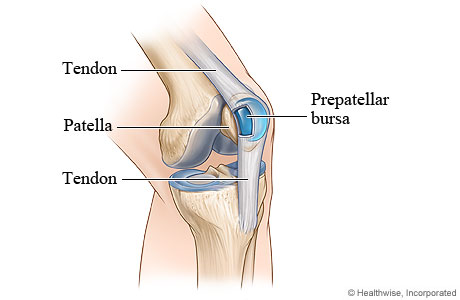Jump to
Bursitis of the Knee

Bursitis of the knee is inflammation of the bursa found between the front of the kneecap (patella) and the skin.
A bursa is a fluid-filled sac that cushions and lubricates areas of the body where friction is likely to occur. Examples of such areas include between two bones, between a tendon or ligament and a bone, and between bone and skin.
How can you care for yourself when you have kneecap bursitis?
- Put ice or a cold pack on your kneecap for 10 to 20 minutes at a time. Put a thin cloth between the ice and your skin.
- After 3 days of using ice, you may use heat on your kneecap. You can use a hot water bottle, a heating pad set on low, or a warm, moist towel.
- Prop up the sore leg on a pillow when you ice it or anytime you sit or lie down during the next 3 days. Try to keep it above the level of your heart. This will help reduce swelling.
- Rest your knee. Stop any activities that cause pain. Switch to activities that do not stress your knee.
- Take your medicines exactly as prescribed. Call your doctor if you think you are having a problem with your medicine.
- Ask your doctor if you can take an over-the-counter pain medicine, such as acetaminophen (Tylenol), ibuprofen (Advil, Motrin), or naproxen (Aleve). Be safe with medicines. Read and follow all instructions on the label.
- To prevent and ease kneecap bursitis during work, play, and daily activities:
- Wear kneepads when kneeling on hard surfaces. Avoid kneeling for too long at a time.
- Strengthen and stretch your leg muscles.
- Avoid deep knee bends.
- You can slowly return to the activity that caused the pain, but do it with less effort until you can do it without pain or swelling. Be sure to warm up before and stretch after you do the activity.
Kneecap bursitis: When to call
Call your doctor now or seek immediate medical care if:
- You have a fever.
- You have increased swelling or redness in your knee area.
- You cannot use your knee, or the pain in your knee gets worse.
Watch closely for changes in your health, and be sure to contact your doctor if:
- You have pain for 2 weeks or longer despite home treatment.
©2011-2025 Healthwise, Incorporated
The content above contains general health information provided by Healthwise, Incorporated, and reviewed by its medical experts. This content should not replace the advice of your healthcare provider. Not all treatments or services described are offered as services by us. For recommended treatments, please consult your healthcare provider.
